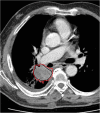Radiomics: the facts and the challenges of image analysis
- PMID: 30426318
- PMCID: PMC6234198
- DOI: 10.1186/s41747-018-0068-z
Radiomics: the facts and the challenges of image analysis
Abstract
Radiomics is an emerging translational field of research aiming to extract mineable high-dimensional data from clinical images. The radiomic process can be divided into distinct steps with definable inputs and outputs, such as image acquisition and reconstruction, image segmentation, features extraction and qualification, analysis, and model building. Each step needs careful evaluation for the construction of robust and reliable models to be transferred into clinical practice for the purposes of prognosis, non-invasive disease tracking, and evaluation of disease response to treatment. After the definition of texture parameters (shape features; first-, second-, and higher-order features), we briefly discuss the origin of the term radiomics and the methods for selecting the parameters useful for a radiomic approach, including cluster analysis, principal component analysis, random forest, neural network, linear/logistic regression, and other. Reproducibility and clinical value of parameters should be firstly tested with internal cross-validation and then validated on independent external cohorts. This article summarises the major issues regarding this multi-step process, focussing in particular on challenges of the extraction of radiomic features from data sets provided by computed tomography, positron emission tomography, and magnetic resonance imaging.
Keywords: Biomarkers; Clinical decision-making; Image processing (computer-assisted); Radiomics; Texture analysis.
Conflict of interest statement
Ethics approval and consent to participate
Not applicable.
Consent for publication
Not applicable.
Competing interests
The authors declare that they have no competing interests.
Publisher’s Note
Springer Nature remains neutral with regard to jurisdictional claims in published maps and institutional affiliations.
Figures




References
-
- Larue Ruben T. H. M., van Timmeren Janna E., de Jong Evelyn E. C., Feliciani Giacomo, Leijenaar Ralph T. H., Schreurs Wendy M. J., Sosef Meindert N., Raat Frank H. P. J., van der Zande Frans H. R., Das Marco, van Elmpt Wouter, Lambin Philippe. Influence of gray level discretization on radiomic feature stability for different CT scanners, tube currents and slice thicknesses: a comprehensive phantom study. Acta Oncologica. 2017;56(11):1544–1553. doi: 10.1080/0284186X.2017.1351624. - DOI - PubMed
-
- Ergen B, Baykara M (2014) Texture based feature extraction methods for content based medical image retrieval systems. Biomed Mater Eng 24:3055–3062. - PubMed
